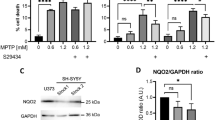Abstract
The effect of 6-hydroxydopamine (6-OHDA) on the level of p53 protein, the activity of caspase-3 and the nuclear morphology-based assessment of cell viability were compared in the nonneuronal CV1-P fibroblast and neuronal SH-SY5Y neuroblastoma cells. The level of p53 protein was increased in the low-dose range (<100 μmol/L) in both cell types, particularly in fibroblasts. In the neuroblastoma cells, a moderate p53 increase paralleled the elevated caspase-3 activity and apoptotic cell behavior. Interestingly, in the fibroblasts at the low 6-OHDA concentrations, p53 remained high during the whole experiment, and there was neither significant caspase-3 activity nor cell death. In the high-dose range (>100 μmol/L), the increase of p53 was reduced and the cell death was predominantly necrotic as judged from the nuclear morphology in both fibroblasts and neuroblastoma cells. Also, the caspase-3 activity was reduced in SH-SY5Y cells. In contrast to some earlier reports, we have shown that the actual 6-OHDA sensitivity of nonneuronal cells may be equal or even higher than that in neuronal cells if the enhancement of p53 levels is used as a criterion for the response. However, the 6-OHDA toxicity was clearly higher in the neuronal than in fibroblast cells.
Similar content being viewed by others
References
Blum D, Wu Y, Nissou M-F, Arnaud S, Benabid A-L, Verna J-M. p53 and Bax activation in 6-hydroxydopamine-induced apoptosis in PC12 cells. Brain Res. 1997;751:139-42.
Blum D, Torch S, Nissou MF, Benabid AL, Verna JM. Extracellular toxicity of 6-hydroxydopamine on PC12 cells. Neurosci Lett. 2000;283:193-6.
Cotran RS, Kumar V, Collins T. Cellular pathology I: cell injury and cell death. In: Cotran RS, Kumar V, Collins T, eds. Robbins pathologic basis of disease. Philadelphia: W.B. Saunders;1999:1-29.
Darzynkiewicz Z, Traganos F. Measurement of apoptosis. Adv Biochem Eng Biotechnol. 1998;62:33-73.
Del Rio MJ, Velez-Pardo C. Monoamine neurotoxins-induced apoptosis in lymphocytes by a common oxidative stress mechanism:involvement of hydrogen peroxide (H2O2), caspase-3, and nuclear factor kappa-B (NF-κB), p53, c-Jun transcription factors. Biochem Pharmacol. 2002;63:677-88.
Dodel RC, Du Y, Bales KR, Ling Z, Carvey PM, Paul SM. Caspase-3-like proteases and 6-hydroxydopamine induced neuronal cell death. Brain Res Mol Brain Res. 1999;64:141-8.
Gangopadhyay S, Jalali F, Reda D, Peacock J, Bristow RG, Benchimol S. Expression of different mutant p53 transgenes in neuroblastoma cells leads to different cellular responses to genotoxic agents. Exp Cell Res. 2002;275:122-31.
Hengartner MO. The biochemistry of apoptosis. Nature. 2000;407:770-6.
Jonsson G, Sachs C. Effects of 6-hydroxydopamine on the uptake and storage of noradrenaline in sympathetic adrenergic neurons. Eur J Pharmacol. 1970;9:141-55.
Kerr JFR, Gobé GC, Winterford CM, Harmon BV. Anatomical methods in cell death. In: Schwartz LM, Osborne BA, eds. Cell death. San Diego: Academic Press;1995:1-28.
Kim HP, Lee EJ, Kim SH, Han HM, Kim YC. Cell death and cytoskeletal alterations in cultured hepatic fat-storing cells induced by 6-hydroxydopamine. Res Commun Mol Pathol Pharmacol. 1998;101:59-68.
Kroemer G, Dallaporta B, Resche-Rigon M. The mitochondrial death/life regulator in apoptosis and necrosis. Annu Rev Physiol. 1998;60:619-42.
Lemasters JJ. Mechanisms of hepatic toxicity. V. Necrapoptosis and the mitochondrial permeability transition:shared pathways to necrosis and apoptosis. Am J Physiol. 1999;276:G1-6.
Levine AJ. p53, the cellular gatekeeper for growth and division. Cell. 1997;88:323-31.
Mayo JC, Sainz RM, Antolin I, Rodriguez C. Ultrastructural confirmation of neuronal protection by melatonin against the neurotoxin 6-hydroxydopamine cell damage. Brain Res. 1999;818:221-7.
Ochu EE, Rothwell NJ, Waters CM. Caspases mediate 6-hydroxydopamine-induced apoptosis but not necrosis in PC12 cells. J Neurochem. 1998;70:2637-40.
Seitz G, Stegmann HB, Jäger HH, et al. Neuroblastoma cells expressing the noradrenaline transporter are destroyed more selectively by 6-fluorodopamine than by 6-hydroxydopamine. J Neurochem. 2000;75:511-20.
Single B, Leist M, Nicotera P. Differential effects of bcl-2 on cell death triggered under ATP-depleting conditions. Exp Cell Res. 2001;262:8-16.
Storch A, Kaftan A, Burkhardt K, Schwarz J. 6-Hydroxydopamine toxicity towards human SH-SY5Y dopaminergic neuroblastoma cells: independent of mitochondrial energy metabolism. J Neural Transm. 2000;107:281-93.
Tatton WG, Olanow CW. Apoptosis in neurodegenerative diseases: the role of mitochondria. Biochim Biophys Acta. 1999;1410:195-213.
Thornberry NA, Lazebnik Y. Caspases: enemies within. Science. 1998;281:1312-6.
Ungerstedt U. Postsynaptic supersensitivity after 6-hydroxydopamine induced degeneration of the nigro-striatal dopamine system. Acta Physiol Scand. 1971;82:69-93.
Uretsky NJ, Iversen LL. Effects of 6-hydroxydopamine on catecholamine containing neurones in the rat brain. J Neurochem. 1970;17:269-78.
Walkinshaw G, Waters CM. Neurotoxin-induced cell death in neuronal PC12 cells is mediated by induction of apoptosis. Neuroscience. 1994;63:975-87.
Wu Y, Blum D, Nissou MF, Benabid AL, Verna JM. Unlike MPP+, apoptosis induced by 6-OHDA in PC12 cells is independent of mitochondrial inhibition. Neurosci Lett. 1996;221:69-71.
Zimmermann KC, Bonzon C, Green DR. The machinery of programmed cell death. Pharmacol Ther. 2001;92:57-70.
Author information
Authors and Affiliations
Rights and permissions
About this article
Cite this article
Puttonen, K., Maňáková, Š., Raasmaja, A. et al. Increased p53 levels without caspase-3 activity and change of cell viability in 6-hydroxydopamine-treated CV1-P cells. Cell Biol Toxicol 19, 177–187 (2003). https://doi.org/10.1023/A:1024767415517
Issue Date:
DOI: https://doi.org/10.1023/A:1024767415517




